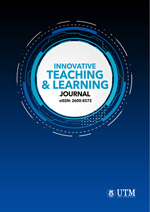Factors and Challenges in Implementing Blended Learning in English Language Teaching at Tertiary Level
Abstract
Many universities are implementing blended learning as an effective instructional paradigm integrating the positive features of online learning and face-to-face instruction. In this descriptive case study, the researcher explores the factors and challenges influencing blended learning implementation in English Language Teaching (ELT) in a Malaysian public university. The researcher adopted a mixed-method research design where both quantitative and qualitative data were collected by the following research instruments: survey questionnaire, semi-structured interview guide and document analysis. Respondents to the questionnaire were 19 English language instructors; data saturation was reached after three audio-taped semi-structured interviews; and the researcher gained access to the e-Learning portals of four instructors for document analysis. Descriptive statistics via the statistical package for social science (SPSS) were used to analyse the quantitative data, and thematic analysis was used for analysing the qualitative data. Both qualitative and quantitative data were combined; however, this article will focus mainly on the qualitative findings of the research. The findings show that all instructors used blended learning in their classes especially as a resource pool. In addition, while the instructors’ technological training and their positive attitudes toward using technology tools in their teaching were recognized as factors enhancing blended learning, the poor technological infrastructure and heavy workload were identified as major challenges hindering the optimal utilization of blended learning. The study signals the need to address workload and technology related issues in order to optimize blended learning utilization in ELT at tertiary level.
















